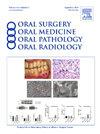一项使用智能手机即时照护自体荧光装置的临床成像研究,以促进初级和社区卫生临床环境中口腔癌的早期检测
IF 1.9
3区 医学
Q2 DENTISTRY, ORAL SURGERY & MEDICINE
Oral Surgery Oral Medicine Oral Pathology Oral Radiology
Pub Date : 2025-07-21
DOI:10.1016/j.oooo.2025.04.081
引用次数: 0
摘要
口腔癌的早期诊断是改善预后和患者预后的关键。一线牙科和医疗从业人员经常遇到可疑的口腔病变,他们必须决定是否将患者转介给专家进行活检和组织病理学检查,这是诊断的黄金标准。开发客观的口腔黏膜病变筛查工具,实现临床风险分层,对于提高口腔癌的早期发现是必不可少的,特别是在资源有限的初级保健环境中。方法和材料移动口腔癌检测(mDOC)设备是一种智能手机自身荧光成像系统,使用定制3D打印盒中的光学元件捕获口腔粘膜的广域白光和自身荧光图像。开发了一个定制的Android应用程序来收集患者的人口统计信息,并指导临床医生收集口腔宽视场图像。病变的具体特征也被记录在应用程序中。这项研究招募了到uthehealth牙科学院和MD安德森癌症中心诊所就诊的患者进行临床评估。转诊决定由专家临床医生决定。结果初步结果包括111例患者223个解剖部位的白光和自身荧光图像数据。在这223个站点中,174个站点提示转诊进行进一步评估,49个站点根据专家临床印象不提示转诊进行进一步评估。该数据集被用于开发一种自动算法,以在护理点生成转诊决策。结论mDOC装置是一种简单的口腔黏膜成像工具,可用于客观筛查,有可能在初级保健机构中早期发现口腔病变。未来的工作包括实施诊断算法,以确定患者是否需要进一步评估,从而为站点级和患者级转诊决策提供信息。本文章由计算机程序翻译,如有差异,请以英文原文为准。
A clinical imaging study using a smartphone point-of-care autofluorescence device to facilitate the early detection of oral cancer in primary and community health clinical settings
Introduction
Early diagnosis of oral cancer is key to improving prognosis and patient outcomes. Suspicious oral lesions are often encountered by front-line dental and medical practitioners who must decide whether to refer the patient to a specialist for biopsy and histopathology, which is the gold standard for diagnosis. The development of objective tools for screening of oral mucosal lesions that enable clinical risk stratification is imperative for improving early detection of oral cancer, especially in resource-limited primary care settings.
Methods and Materials
The mobile Detection of Oral Cancer (mDOC) device is a smartphone autofluorescence imaging system that captures wide field white light and autofluorescence images of the oral mucosa using optics in a custom 3D printed case. A custom Android application was developed to collect patient demographic information and to guide the clinician to collect widefield images in the oral cavity. Lesion specific characteristics are also recorded in the app. This study enrolled patients presenting to the UTHealth School of Dentistry and MD Anderson Cancer Center clinics for clinical evaluation. Referral decisions were determined by expert clinicians.
Results
Preliminary results consist of white light and autofluorescence image data from a total of 223 anatomic sites in 111 patients. Of these 223 sites, 174 sites prompted referral for further evaluation and 49 sites did not prompt referral for further evaluation based on expert clinical impression. This dataset is being used to develop an automated algorithm to generate a referral decision at the point of care.
Conclusion
The mDOC device serves as a simple tool to image the oral mucosa for objective screening, with the potential to enable earlier detection of oral lesions in primary care settings. Future work involves the implementation of diagnostic algorithms to inform site-level and patient-level referral decisions to determine whether a patient requires further evaluation.
求助全文
通过发布文献求助,成功后即可免费获取论文全文。
去求助
来源期刊

Oral Surgery Oral Medicine Oral Pathology Oral Radiology
DENTISTRY, ORAL SURGERY & MEDICINE-
CiteScore
3.80
自引率
6.90%
发文量
1217
审稿时长
2-4 weeks
期刊介绍:
Oral Surgery, Oral Medicine, Oral Pathology and Oral Radiology is required reading for anyone in the fields of oral surgery, oral medicine, oral pathology, oral radiology or advanced general practice dentistry. It is the only major dental journal that provides a practical and complete overview of the medical and surgical techniques of dental practice in four areas. Topics covered include such current issues as dental implants, treatment of HIV-infected patients, and evaluation and treatment of TMJ disorders. The official publication for nine societies, the Journal is recommended for initial purchase in the Brandon Hill study, Selected List of Books and Journals for the Small Medical Library.
 求助内容:
求助内容: 应助结果提醒方式:
应助结果提醒方式:


